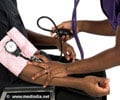College football players may develop high blood pressure over the course of their first season, shows study published in journal Circulation.

Researchers also examined changes in endurance-trained competitive rowers, but found no corresponding increase in blood pressure, suggesting the phenomenon may be related to periodic episodes of intense exertion such as football, Baggish said.Overall, blood pressure levels averaged 116/64 millimeters of mercury (mm Hg) – which is normal – before the season, but afterward rose to an average 125/66 mm Hg, which is pre-hypertensive. Players on the offensive or defensive line who gain weight during the season and have a family history of high blood pressure were most likely to have post-season hypertension.Researchers also noted structural changes in players' left ventricle, the heart's main pumping chamber, which can be a potential indicator of worsening heart health since it can grow thicker if the chamber is overworked. In this study, left ventricle thickening (left ventricular hypertrophy) was more prevalent among football players than endurance athletes, and it was significantly greater among linemen.
"Importantly, left ventricular hypertrophy among football players was strongly associated with resting blood pressure suggesting that heart remodeling in some athletes may be due to what happens off the playing field," he said."Considering the popularity of football in the United States, I believe this knowledge of an association with enhanced prevalence of prehypertension and stage 1 hypertension after one season in some players is extremely important," said American Heart Association spokesperson Ernesto Schiffrin, M.D., Ph.D., who is not affiliated with the study. "However, the study should not be interpreted to mean that playing football causes hypertension. Instead, it suggests increased surveillance particularly in those most susceptible: those with a family history of hypertension or playing on the offensive or defensive line."Professional football players tend to have higher rates of both hypertension and premature death from heart disease, especially linemen, Baggish noted. He and his colleagues are continuing to monitor players identified as at-risk to gain a better understanding of hypertension and heart disease, if and when it develops, as they age.
Source-Eurekalert















